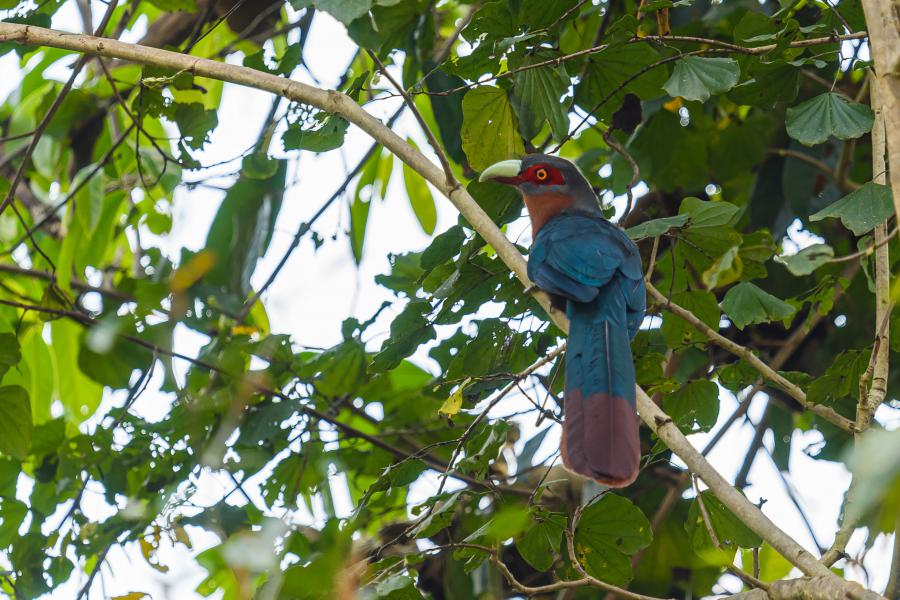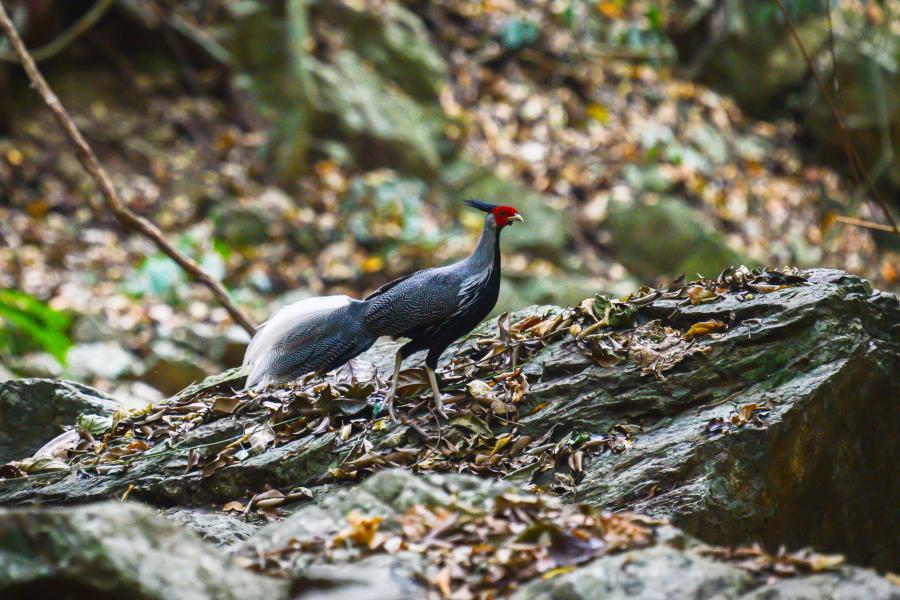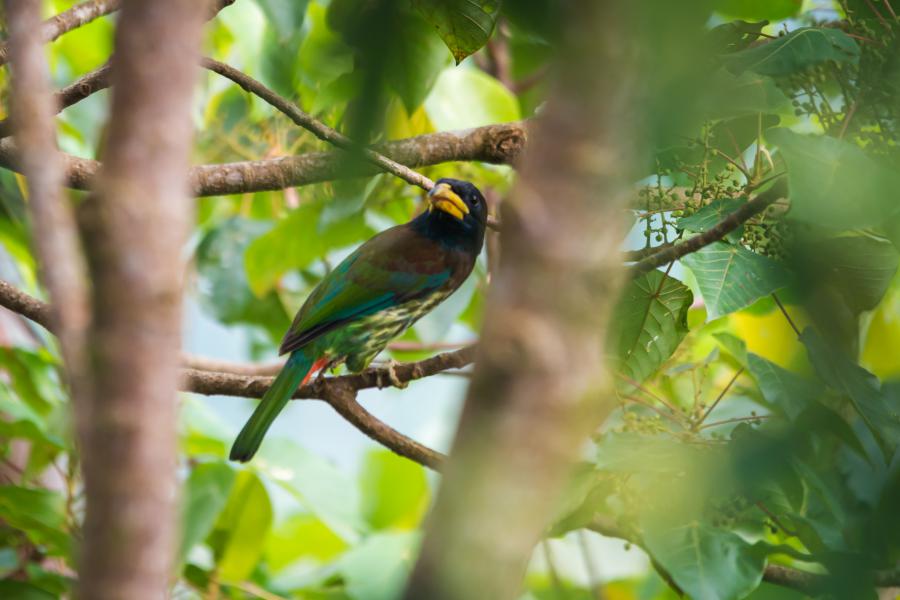Birdwatching in Kaeng Krachan
According to serious birders regularly coming to Kaeng Krachan, the park is the top forested birdwatching location in Mainland Asia. Consisting mainly of evergreen forests, the park is also covered with dry forest and mixed deciduous forest spread over altitudes ranging from 100 up to 1500 m asl, making it possible to see a vast variety of bird species, some of them very rare.
Although birdwatching possibilities are relatively good at all times, March to April is the most ideal time when bird migration into the park is at its peak and continues a bit until June/July when birds take care of their hatchlings. To see a long list of bird species found in Kaeng Krachan, please visit our wildlife page.
Km 0-15
An exciting journey into this park begins at Sam Yod checkpoint which is kilometre 1.7, this is the reference point for the 36.5 km long road through the central parts of the park. There are several saltlicks, waterholes, fruit trees and a few smaller stream crossings along the road.
Few hundred meters into the road from the entrance on the left side there is a big water reservoir. Birders are often seen stopping at the reservoir to watch black-thighed falconets, ospreys and black-and-red broadbills. Few kilometers into the road on the right side, right at the end of a sharp bend downhill an oriental pied hornbill nest can be seen in the hollow of a tree trunk. The view to this tree is clear and can be seen from the road, ideal for photography with good depth of field behind during the nesting time. As the tree is quite far from the road, there is no risk of disturbing the hornbills.
Common birds further into the road are sultan tits, black-naped orioles, greater flamebacks, vernal hanging parrots, black-naped woodpeckers, greater yellownapes, crested goshawks, thick-billed green pigeons, sooty-headed bulbuls and many more.
The saltlicks around km 7-8 are a good spot to see large scimitar babblers, black-headed bulbuls and common flamebacks.
Various owls, nightjars, woodpeckers and many others can be seen during late hours of the day. One particular good spot to see these birds is around km 9 (6 km east from Ban Krang Campsite), it is a smaller bridge over a tiny stream. Large-tailed nightjars, great eared nightjars, crested serpent eagles, spot-bellied eagle-owls, collared scops owls, lesser yellownapes, common flamebacks, streak-breasted woodpeckers and common green magpies is just few of many exciting birds that has been spotted there. On fruit trees further up the road towards Baan Krang golden-crested mynas, eyebrowed thrushes and thick-billed flowerpeckers may be seen. Various owls can be heard from late afternoon onwards from the campsite and along the road.
Ban Krang Campsite, km 15
The area we refer to as Ban Krang here is not only the campground but also the three river crossings along the dirt road west including a small dam at km 18.6 (3.5 km west from the campsite), about a kilometre of paved road east and a couple of kilometres of dirt road south from the campground.
After the sunset visitors are not allowed to walk out more than a couple of hundred meters in any direction for a very good reason; wild animals, especially elephants are very common in the area. There are reports about visitors walking a bit too far and seeing their way back to the campsite blocked by wild elephants.
The vicinity of Baan Krang is one of the very few places where the rare and vulnerable white-fronted scops owls may be seen, but the sighting is rare. They show up now and then and stick around for a while. It is high up on many birdwatchers' wishlists. Another species to watch after is black-and-red broadbills, Phang Nga and Kaeng Krachan are the only reliable places in Thailand to see this interesting bird. Some other interesting rare birds seen in this area are banded kingfishers and rufous-collared kingfishers.



The campsite and 1 km east
Baan Krang is one of very few places where the rare and vulnerable white-fronted scops owl can be seen, it is on top of many birdwatchers list coming to Kaeng Krachan. Another specie to watch after is black-and-red broadbill, Phang Nga and Kaeng Krachan are the only reliable places in Thailand to see this interesting bird. Some other interesting rare birds seen in this area are banded kingfisher and rufous-collared kingfisher.
Presence of few fruit trees in and around a couple of hundred meters from campsites makes birdwatching very easy when the trees are fruiting. Sometimes it is possible to sit and enjoy oriental pied hornbills or great hornbills flying in and out for more or less an hour to a big tree just down the road from the restaurant. Another busy hornbill route is a tree a few hundred meters east on the same road. These trees also attracts other bird species like black-crested bulbuls, Asian fairy-bluebirds, green-eared barbets, blue-throated barbets, blue-winged leafbirds, stripe-throated bulbuls and black-crested bulbuls, occasionally also great hornbills and brown hornbills.
Little egrets are seen often on the Pranburi stream next to the camping ground but the safest place to find them is around the bigger ponds between the checkpoint and Ban Krang. During the breeding season broadbills nests on branches over the water stream. Pond herons are sometimes seen feeding on the grass in the campground.
Km 15-18.6
The Pranburi Stream crosses 3.6 km of the dirt road west from the campsite at three locations, making it an interesting spot all year round. Most of the bird species seen around the campsite can be seen along this 3.6 km bit of the dirt but also dusky broadbills, silver-breasted broadbills, black-and-yellow broadbills, woodpeckers and a few rare pitta species, most interesting blue pittas.
Some of the more interesting birds recorded in this area are white-fronted scops owls, collared owlets, brown fish owls and Malaysian night-herons.
The right side of the road after the third crossing is probably the easiest place to see orange-breasted trogons among many other birds. During the dry season it is relatively easy to walk off the trails between trees, good visibility, no risk to get lost as the water stream is not too far away. Other birds common in this area until the dam are big blue-bearded bee-eaters and white-rumped shamas.
Phanoen Thung, km 30
Road to Phanoen Thung and km 27.5
The road after the small dam (km 18.5) becomes more interesting to see some ground dwelling birds; grey peacock-pheasants, kalij pheasants, red junglefowls and some partridge species are regularly seen on the road. Although the subject is birds, it is worth mentioning that most leopard sightings have been reported around km 22-23, good to keep in mind.

The most interesting spot along this route is no doubt km 27.5. It is a smaller open area on the right side of the road, referred to as "smaller parking area", some also call it "the tree". Few hundred meters up the road there is a huge tree. When the tree happens to have fruits it attracts many birds. This area is still interesting even though the tree is not blooming. A kilometer up and down the road gives opportunity to see many bird species, some worth to mention; the rare ratchet-tailed treepies, silver orioles, blue-throated barbets, black-naped monarchs, red-bearded bee-eaters, long-tailed broadbills, red-headed trogons, rusty-naped pittas.
The campsite
There are multiple locations in the vicinity of the campsite ideal for birdwatching; the "pavilion"nish small viewpoint next to entrance, the main view point 300 m down the road west, the Royal Residence a few hundred meters further down and a very short "Orchid Nature Trail".
The most common birds around the camping ground are no doubt several bulbul species with flavescent bulbuls being the most common. Few other bulbul species often seen are; mountain bulbuls, ashy bulbuls, streaked bulbuls, grey-eyed bulbuls and black-crested bulbuls. There are several fruit trees on the "viewpoint" end of the campground. If trees have fruits it may give the opportunity to see great barbets, blue-throated barbets, bulbuls, thick-billed and yellow-vented green pigeons. Among those trees there is one banana tree that regularly attracts streaked spiderhunters.
The road to Phaneon Thung and further west from the campsite is probably the best place to target wreathed hornbills.
Royal Residence
Around 400 m down the road west from Phanoen Thung there is a road gate on the right side blocking the road up to the hill. This road leads to the Royal Residence and several premises a few hundred meters up. It is possible to walk around the gate and go up. The pavilion-ish viewpoint half way up on the left side is the most popular place to get a chance to see the very rare ratchet-tailed treepies, the huge tree behind is the one to look after. Piculets among many other bush-birds are very common all the way up.
Further down the road, to km 36.5
The road further west continues on a mountain ridge, has quite many beautiful open views and viewpoints on both sides. This bit of the road is the most ideal place in the park to see raptors circulating above or diving after a prey. Black bazas, mountain hawk-eagles, crested serpent-eagles, rufous-bellied eagles and rufous-bellied eagles are only a few of many exciting birds seen from time to time, most of them relatively common. Plain-pouched hornbills are another exciting bird found in this area.
Also worth mentioning, km 34-36 is an ideal place to find stump-tailed macaques, Indochinese serow, clouded leopards any many other exciting mammals.
Dark-necked tailorbirds and white-browed piculets are easily found on bushes along the road, pin-striped tit-babblers are also very common.